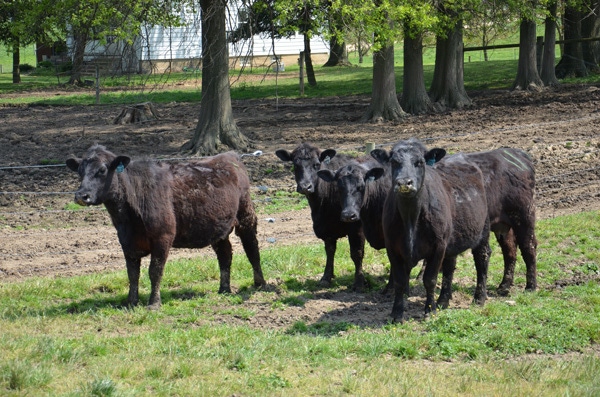More ranchers are finding that custom heifer development cuts cost and improves breeding percent.
August 6, 2020

Custom heifer development is a common feature of successful dairy farm businesses; where youngstock are sent away from the home dairy for rearing, breeding and return at freshening. Several university research stations and commercial operators are proving that beef producers can find just as much success in sending beef heifers off-farm for development.
Why send heifers away?
Arturo Pacheco, based in the Flint Hills of Kansas, is one such commercial custom heifer developer. A nutritional consultant by training, Pacheco began raising heifers for some of his clients several years ago.
The reasons for sending heifers to a custom developer differ from ranch to ranch. “Some of our customers wanted to fully stock up their home farms with productive cows, while other small customers didn’t feel comfortable working with AI and wanted to contract out their breeding,” Pacheco says.
These reasons appear to be a common theme among custom developers. William Storer of McNeese State University, Lake Charles, La., finds his customers enjoy the benefits of sending their heifers to the University research station. “We have a lot of older ranchers in the area, and they don’t want to mess with feeding heifers over winter and trying to AI breed small numbers of heifers in often poor-quality handling facilities.”
The benefits of custom developing heifers include increasing cow stocking rate on the home farm; easier use of synchronized AI breeding protocols; no in-breeding risks from stock bulls on the home farm; less labor and feed costs on home farm, and; often better weight gain and animal performance achieved by the custom developer.
Getting heifers ready for the developer
Landon Marks and Kent Stanford at Alabama Cooperative Extension’s Sand Mountain Elite Heifer Development Station develop 60 heifers annually. Ensuring heifers are well prepared on the home farm before arriving at the developing station is an important part of their program.
“We sometimes see heifers lose weight for the first month when they arrive to our grazing program if they’re not used to grazing,” Marks says. If heifers have been in a drylot during the weaning period, the change of diet leads to weight loss even though Marks’ team does their best to adjust from a hay/grain diet.
“Once they get going after a month, it’s common to see heifers gain 100 pounds in the following month,” Marks says. Storer encourages cow-calf producers to only send well grown heifers to the program, and charges customers on a weight gain basis.
“In our feedlot development, heifers arriving under 500 pounds struggle to make breeding weights and hit performance targets. Paying by weight gain encourages owners to only send good heifers that have potential to perform.”
Strict health vaccination and worming plans are often requirements that producers must adhere to before they send heifers to a developer. As most developers group heifers from several ranches together, a high health status is necessary to protect against a disease outbreak.
Developer’s responsibilities
Once arrived at the developing station, the custom developer typically takes care of all management and diet decisions. “We treat ‘em like a cow and don’t push them too hard,” says Pacheco, who runs his heifers on rangeland, with forage hay and energy/protein supplement offered during the winter months when grass is scarce.
McNeese University feedlots their heifers for 120-day feed trial research and student education, before transitioning to a breeding period after the feed trial is complete. “We send monthly weight gain reports to the owners during the trial,” Storer says.
After the 120 days, the McNeese team carry out ultrasound carcass scanning and relays these reports to the owners. “Not many guys in the area do retained ownership to slaughter, but the carcass reports are allowing our heifer owners to see how their stock perform on a good program and make better informed decisions.”
Synchronizing heifers to fixed time AI is one of the main benefits custom developers offer their customers. Owners are typically allowed to pick what AI straws they want heifers settled to. Both Marks and Pacheco have found success with a Select Synch fixed time AI program. “This program usually gets 70% conception to one-time AI, followed by an easy calving Angus stock clean-up bull,” Pacheco says.
Return home
Heifers at Sand Mountain Elite Heifer Station return to the owners in late June, just as grass quality begins to deteriorate in the summer heat at the station. The heifers return with pregnancy scanning, weight gain, ultrasound carcass, foot scoring, pelvic and behavior data.
“One great thing about our program’s data is it shows owners exactly how their heifers perform on well managed rotational grazing,” Marks says. All three custom developers share performance data with all the owners, so owners can benchmark their ranch performance and improve toward consistently top-performing heifers.
“One of my best customers has made massive genetic and performance improvements over the last few years by only retaining AI-bred heifer calves out of first lactation heifers. It’s encouraging other ranchers to follow the same route,” Pacheco says.
Costs
Costs vary depending on the duration of the development, with some custom developers charging $2 per head per day, while other charge a flat $400 per head for six months development and breeding. “Cow-calf guys can’t rear heifers as cheap at home and we can give them an opportunity to see how cattle perform with all the data feedback,” Storer says. With repeat customers returning annually, these custom developers see the demand for this type of service becoming more widespread throughout the industry.
Cox is a dairy producer and freelance beef/dairy writer based in Missouri. The opinions of the author are not necessarily those of beefmagazine.com or Farm Progress.
You May Also Like



